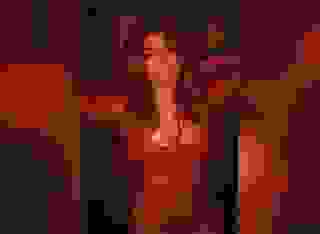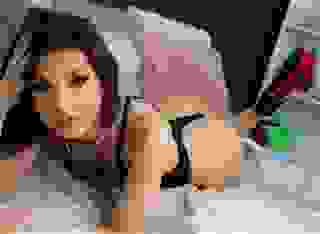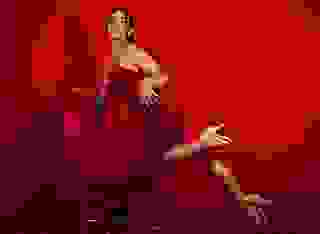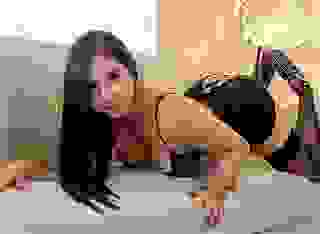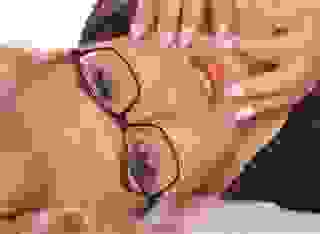Note: You can change font size, font face, and turn on dark mode by clicking the "A" icon tab in the Story Info Box.
You can temporarily switch back to a Classic Literotica® experience during our ongoing public Beta testing. Please consider leaving feedback on issues you experience or suggest improvements.
Click here"Morning." Kara sighed, rubbing noses gently with her twin.
"Morning." Arryn replied, her hand dipping under the blankets. She cupped Kara's pussy, causing her sister to groan and spread her silky thighs.
Arryn looked up at Kara. "What are you doing up? Come back to bed!" Kara said.
Arryn grinned and climbed back in with her sister, and they welcomed her with open arms. She lowered her lips to Kara's and gave her a long, sensual kiss.
"I think this is a great day to stay in bed, don't you guys?" she asked.
"Definitely!" Arryn agreed.
"Mmhmm..." Kara answered dreamily as she slowly closed her eyes. Arryn's fingers were already setting her pussy on fire with their teasing touch.
The sisters giggled and cuddled into each other's arms, ready for a long day of incestuous love making.
Elsewhere in Central City.......................
There was a large building, called the Pro-bending Arena. The Pro-bending Arena was the venue that hosted official pro-bending matches in Central City. A golden building located at the end of a long causeway, the stadium is a prominent city landmark. Much of the arena was damaged following an Equalist attack in the 1730s, and it was shut down soon after by the authorities. The arena reopened within the six months following the Anti-bending Revolution, continuing to host pro-bending matches and other events.
After the founding of Central City, the Pro-bending Arena was built, becoming the first ever establishment to host pro-bending matches. During Mako and Bolin's street life following the loss of their parents, Toza, a former pro-bender, discovered the sisters fighting in town and offered them a place to live in his attic while letting them work odd jobs to pay rent, which allowed them to form a pro-bending team, the Future Industries Fire Ferrets. When Avatar Korra moved to Central City to start her airbending training under the tutelage of Tenzin, pro-bending immediately called her attention. She asked Tenzin if she could attend a match at the arena, to which the airbender categorically refused. One night, however, the Avatar secretly left Air Temple Island and infiltrated the arena, accidentally stumbling into the gym, where Toza caught her and told her to leave immediately, thinking she was trying to sneak in without paying. Bolin appeared and pretended they were together in order to get her out of trouble, before showing Korra the arena from one of the locker rooms, which left the Avatar amazed. The United Republic Council was later threatened by Amon to shut down the arena for the championship match, or 'severe consequences' would follow. The Council initially agreed to do so; however, Chief Lin Beifong subsequently intervened, stating that she would protect the arena and the spectators with her metalbending officers, making the majority of the Councilors change their opinion on the matter. When the White Falls Wolfbats deceptively won the match, Equalists who had infiltrated as spectators proceeded to stun the police officers, Lin, and Tenzin with their electrified gloves while Amon and some of his men entered the ring, overpowering the members of the victorious team and removing their bending. At their escape through the arena's glass ceiling via airship, a bomb was detonated in the ring, destroying a large part of it. Avatar Korra and Lin tried to stop the Equalists by pursuing them, and a battle subsequently ensued on the roof. However, after knocking the Lieutenant off of the dome rooftop, the glass beneath Korra broke and she began to fall, forcing Lin to abort her chase and save the young Avatar. After this attack, the Pro-bending Arena was closed down, forcing Mako and Bolin to leave their home and move to the Sato estate at Asami's invitation. After the Equalists' success during the battle for Central City, the Pro-bending Arena was covered in Equalist banners and was the chosen location for the Equalist victory rally. As Amon was speaking to the crowd at the rally, however, she was exposed as a waterbender by Avatar Korra, to which the crowd did not believe. An intense battle ensued, with Korra eventually blasting Amon into the harbor via airbending. Amon began to waterbend to prevent herself from drowning, much to the shock of her former supporters, and fled the scene. Six months after the Anti-bending Revolution, the arena was rebuilt and pro-bending matches resumed at the venue. The arena was later used to air the finale of The Adventures of Nuktuk: Hero of the South, with sound amplification systems on the playing field and a screen above it. During the airing, Varrick attempted to kidnap President Raiko and his wife using gangsters disguised as Northerners, hoping to force him into supporting the Southern Water Tribe in the Water Tribe Civil War. This attempt was thwarted by Bolin, and a battle between him and the gangsters ensued on the ring. After the waterbender revealed Varrick to be the mastermind, Lin Beifong and her officers surrounded Varrick and had him arrested along with his assistant, Zhu Li. A week after the Unalaq Crisis, the arena was used to hold a special tournament to sponsor the rebuilding of the city.
The Pro-bending Arena is a colossal, glass-domed structure located on a man-made platform in Yue Bay; a causeway connects the building entrance to the mainland. As a testament to the sport's popularity, the arena's exterior has a golden appearance and is lit at night. The building consists of a rectangular structure with four tall pillars at each corner and a quaint entrance in the side facing the city. Most of the arena sits underneath an intricate glass-domed ceiling. Two inlets come out from the sides of the main platform that supports the building over the sea; two small pavilions are located at their ends. The arena is spacious enough to hold the ring, a large pool of water below it, seating for spectators, and at least one practice gym. It also has an impressive sound amplification system, as announcers use microphones to transmit their voice throughout the entire arena.
The playing field consists of a ring and a water pit. Located at the center of the arena, the pro-bending ring is a hexagonal platform where the teams compete in matches. It is separated into two equal sides, one red and one blue, with each split into three zones. Raised at a considerable height, the ring is supported by thick columns that erect out of a water pit below. In addition, twenty-one small discs made of earth are available on each side, recessed into the arena itself, for earthbenders to utilize during competition, while grates run along the lines between zones allowing waterbenders to access water from troughs under the ring. There are also flexible, bouncy ropes on the peripheral sides of the ring, while the two opposing ends are open to a long drop to the water below. The playing field also has several mobile platforms that allow players to enter the ring. Referees monitor the ring from raised stands at its sides.
The arena has a great number of seats available for spectators. The bleachers are arranged in a staggered manner, forming long, tiered rows of seats with stairs that provide access to the chairs. There are also more private and exclusive balconies and boxes for particularly powerful or wealthy citizens and guests that include comfortable and elegant red seats, which were installed after Amon's attacks on the stadium. There is a Presidential Box destined to the President of the United Republic of Nations and their guests, such as the First Gentleman.
There is a centered, rectangular shaped booth on one side of the arena that has a complete view of the playing field. Radio broadcasters such as Shiro Shinobi sit in the booth and provide their take on the match to the radio audience.
Within the building lies Toza's gym, where the Fire Ferrets often practiced. Its attic was formerly Mako and Bolin's home. The gym is a large place where teams can train for matches. It includes the necessary tools for practice: earth disks, nets, weights, punching bags, etc.
The attic of Toza's gym is the former home of Mako, Bolin, and Pabu. The attic has a small hatch door in the floor for entering and exiting, a loft area, and even a small kitchen-like area for cooking. The attic also provides great views of the surrounding area from its many windows.
The notable figures are the following; Bolin, Butakha, Mako, Pro-bending referees, Pro-bending teams, Ring announcer, Shiro Shinobi, and Toza.
Pro-bending is a popular sport originating in Central City that involves two teams of three benders, one from each of the different bending arts including airbending. The objective of the sport is to gain as much territory within the ring as possible within three minutes, or, alternatively, to drive the members of the opposing team over the edge of the ring.
The interior of the arena includes a playing field, water pit, and an intricate glass-domed ceiling. The playing field is hexagonal, split into two sides, one red and one blue, with each side split into three zones. On each side of the playing field are twenty-one holes that dispense miniature rock discs, similar to earth coins, for the earthbending competitors. Grates run along the lines between the zones, allowing waterbenders to access water from troughs under the ring. The grates also mark a zone in the arena and can light up green to signal a team can move forward or red to indicate a penalty. There are flexible, bouncy ropes on the peripheral sides of the ring, but the two opposing ends of the ring are open to a long drop to the water below. Referees look over the ring from raised stands by its sides. The rock discs dispensed from the arena are circular, and slightly larger than half a foot in diameter. They are made of hard clay that, while not being particularly soft, will still break if the disc hits a player hard enough. Under each disc is a second that will rise up to become flush with the ground when the first is dispensed. These discs are mainly used as weapons in the match but can effectively be used as a shield. When broken, the discs leave a cloud of dust which could be used for cover to strike the opponent without being seen.
At the start of the match, each team must remain within the first zone nearest to the center of the arena. Once a competitor is knocked into zone two by someone from the opposing team, he or she must stay there and cannot return to zone one. The same rules apply if he or she crosses over to zone three. If a player is completely knocked off the back of the ring, they cannot return to the field in that round, but can return for the next round if there is one.
If all three members from one team are knocked back into zone two, a green light appears in the center line and the opposing team can advance into zone one on the other side; if they do this, they cannot move backward into their own zone. If they manage to knock all of the opposing team members into zone three, another green light appears between zones one and two, and they can advance again into zone two. However, if a team that has been pushed back manages to push the other team back a zone, they can advance forward one zone. The main objective for both teams is to push the other team back, thereby gaining territory. Each match consists of three rounds of three minutes each. The team that has managed to gain the most territory within the time frame wins the round. This means that even if two players from one team have been knocked out, that team can still win if the remaining player manages to gain the most territory by the end of the round. If both sides have not gained any territory, the team with the most players left wins. Otherwise, the round is a draw, resulting in a tie-breaker. At the beginning of the tie-breaker, the referee flips a coin, with each side of the coin corresponding to one team, either blue or red. The team that wins the coin toss decides the element that is challenged. If the winning team chooses "fire" for instance, the firebenders fight it out; the winner of the one-on-one wins the round. The tie-breaker is conducted on a raised platform positioned at the very center of the ring. An alternative method to win is to complete a knockout, where all three players of the opposing team are knocked out of the ring during the same round. A knockout results in an automatic win of the match, regardless of whether or not the opponents won more rounds. Game play only continues if any given player manages to return to the playing field before contacting the water pit, either by hanging onto the edge of the arena and returning to the surface or by helping another team member return to the arena.
Each water blast can exceed one second in duration, meaning that waterbenders may use any form of a constant hose-like stream of water against their opponents. Water can be used in its liquid state, as a gas or a solid, meaning that steam, fog, and ice are allowed in game play; it cannot be filled with anything, such as earth. Water is the only element for which head strikes are allowed. Waterbenders can only access water within their zone, specifically from the metal grates directly in front and behind the zone that the player is currently occupying. Water may only be pulled up from the zone lines, and not from any outside sources, such as the water below the ring.
Unlike waterbending, no direct earth strikes can be aimed toward an opponent's head. Since the ring is comprised mostly of canvas-covered metal, metalbending is permitted. Earthbenders may bend earth in its raw form, and as sand or dust. Earthbenders are not restricted to bending regulation rock discs supplied through the floor of the ring, and may bend discs from their own zone. Rock discs may be broken down intentionally into smaller pieces. Though the bending of several discs at one time is allowed, they can bend full stacks of discs at once. Players may ricochet or deflect discs off the side ropes, like air hockey.
Each fire blast must exceed one second in duration, meaning that firebenders may use constant flamethrower-like streams of fire against their opponents. No direct fire strikes toward an opponent's head are permitted. Like water and earthbenders, firebending pro-benders are not restricted with how they produce their own flames, but are not prohibited from using lightning generation during game play.
Air blasts and strikes could be used to stun the opponents of the team. Air blasts could also be used to redirect any solid attack of the elements.
Dark blasts and strikes could be used only to shadow the area in darkness to distract the opponents. However, after 3 minutes, if the shadows haven't stopped, the team will be banned from using it again for the rest of the match.
Light rules are the same as dark blasts and strikes, but instead of shadowing the area in darkness, they would fill the area in light to blind the opponents.
Ice columns and towers must be 6 feet tall, ice discs must be breakable. Head strikes are prohibited.
Lightning blasts and strikes are allowed so long as they are not used to magnetize the metallic items. The redirection of lightning is allowed as long as the redirection is not aimed at the audience or the announcement ring.
Metal bending is allowed as long as the opponents are not restricted to movement. The winners are guaranteed to restrain the losers with metal handcuffs.
Shadow bending and void bending are primarily used to restrain the opponents during the final round when the winning team fucks the losers.
If a player sustains an injury during a match, play is halted and the player is removed from the ring; however, injured participants may be permitted to continue if they are still capable. Players who are injured while being knocked off the ring will be rescued by gaming officials. In both cases, the team must continue the match without a replacement.
No member of any team in the running for the championship may get into a physical confrontation with another player of an opposing team outside of a pro-bending match. If this occurs, the team that instigated the fight will be ejected from the tournament, and the team they were to battle against will move forward. In addition, a competitor may only compete on one team. In the event the Avatar participates in a pro-bending match, he or she may only bend one element.
There are several rule violations that will result in a penalty. Stepping over a line when the proper conditions have not been met, knocking a player off the arena from the sides, and the use of "unnecessary roughness", such as holding a repetitive blast of an element against a fighter, will cost the offender a one-zone penalty. In the case of the Avatar, a penalty may be issued if he or she bends anything other than his or her designated element. In addition, intentionally hitting the referee, the referee stand, or the audience stands with an element is considered a violation. Though they are unlikely to do so, pro-benders are not permitted to hit the roof of the arena with bending. Players who intentionally break a rule may be shown a yellow fan as a warning. Repeat offenders may receive a red fan after receiving a yellow fan, resulting in their removal from the game. The team that has lost a player must continue without a replacement.
A round is won by gaining territory before time runs out. If no team has secured opposing territory by the end of the round, the team with the most number of players remaining wins the round. However, if the team with fewer players has gained more territory by the end of the round, they are declared as the winners of that round.
Matches are won by either winning the most rounds or by executing "knockouts". Knockouts are accomplished when all members of an opposing team are knocked off the back of the ring within one round. Even if a team has won two rounds, they must still play a third round, as a match can end in a knockout at any point.
If a round ends in a deadlock, with neither team gaining territory and having an equal number of players on the field and in each zone, the winner is decided in a tiebreaker "face-off". In a face-off, the referee tosses a coin, and the team that wins the coin toss can decide which player and which element will go into the face-off. Players always face their same element. The face-off takes place on a raised circular platform in the center of the ring. The tiebreaker platform includes a total of four earth dispensers placed on both sides. In the case of water-based tiebreaker, water grates that run along the perimeter as well as the center are raised along with the platform. Players may use their respective elements, along with grappling, so long as there are no "empty hand strikes", particularly punches to the face or kicks to the stomach. The objective is to knock the opposing pro-bender off the circle. The player who falls off first loses the tiebreaker, and the opposing team wins that given round. If both players fall off the circle simultaneously, the player who lands first (hitting either the ring, ropes or the rink) loses the tiebreaker. If the referee cannot determine who landed first in the above scenario, a second tiebreaker is held between two other members, using a different element. When each team has won a round and the third ends in a deadlock, a tiebreaker face-off is used to determine which team wins the match.
The scoreboard is a set of four nixie tubes. From right to left, they read;
第一囬合: Round 1
第二囬合: Round 2
擊倒: Knockout
優勝者: Winner
If both teams should win one of the first two rounds each, and did not knock out their opponents in the third round, the third scoreboard reads;
第三囬合: Round 3
The tubes light up either red or blue to indicate which team won a round, got a knockout, or won the match. The red team is the one that starts on the red half of the field.
